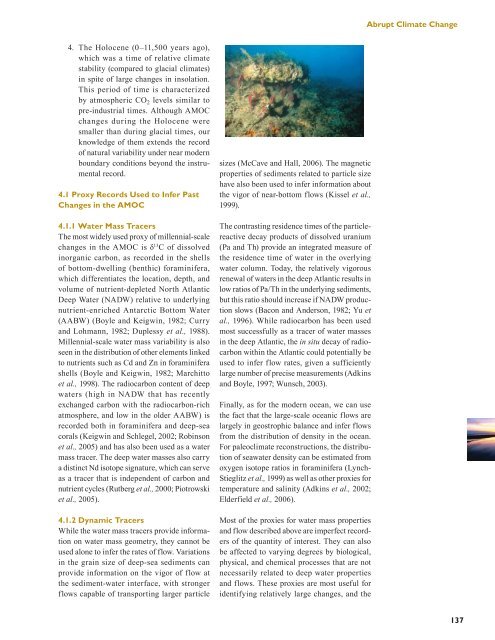Book 2.indb - US Climate Change Science Program
Book 2.indb - US Climate Change Science Program
Book 2.indb - US Climate Change Science Program
- No tags were found...
You also want an ePaper? Increase the reach of your titles
YUMPU automatically turns print PDFs into web optimized ePapers that Google loves.
Abrupt <strong>Climate</strong> <strong>Change</strong>4. The Holocene (0–11,500 years ago),which was a time of relative climatestability (compared to glacial climates)in spite of large changes in insolation.This period of time is characterizedby atmospheric CO 2 levels similar topre-industrial times. Although AMOCchanges during the Holocene weresmaller than during glacial times, ourknowledge of them extends the recordof natural variability under near modernboundary conditions beyond the instrumentalrecord.4.1 Proxy Records Used to Infer Past<strong>Change</strong>s in the AMOC4.1.1 Water Mass TracersThe most widely used proxy of millennial-scalechanges in the AMOC is δ 13 C of dissolvedinorganic carbon, as recorded in the shellsof bottom-dwelling (benthic) foraminifera,which differentiates the location, depth, andvolume of nutrient-depleted North AtlanticDeep Water (NADW) relative to underlyingnutrient-enriched Antarctic Bottom Water(AABW) (Boyle and Keigwin, 1982; Curryand Lohmann, 1982; Duplessy et al., 1988).Millennial-scale water mass variability is alsoseen in the distribution of other elements linkedto nutrients such as Cd and Zn in foraminiferashells (Boyle and Keigwin, 1982; Marchittoet al., 1998). The radiocarbon content of deepwaters (high in NADW that has recentlyexchanged carbon with the radiocarbon-richatmosphere, and low in the older AABW) isrecorded both in foraminifera and deep-seacorals (Keigwin and Schlegel, 2002; Robinsonet al., 2005) and has also been used as a watermass tracer. The deep water masses also carrya distinct Nd isotope signature, which can serveas a tracer that is independent of carbon andnutrient cycles (Rutberg et al., 2000; Piotrowskiet al., 2005).4.1.2 Dynamic TracersWhile the water mass tracers provide informationon water mass geometry, they cannot beused alone to infer the rates of flow. Variationsin the grain size of deep-sea sediments canprovide information on the vigor of flow atthe sediment-water interface, with strongerflows capable of transporting larger particlesizes (McCave and Hall, 2006). The magneticproperties of sediments related to particle sizehave also been used to infer information aboutthe vigor of near-bottom flows (Kissel et al.,1999).The contrasting residence times of the particlereactivedecay products of dissolved uranium(Pa and Th) provide an integrated measure ofthe residence time of water in the overlyingwater column. Today, the relatively vigorousrenewal of waters in the deep Atlantic results inlow ratios of Pa/Th in the underlying sediments,but this ratio should increase if NADW productionslows (Bacon and Anderson, 1982; Yu etal., 1996). While radiocarbon has been usedmost successfully as a tracer of water massesin the deep Atlantic, the in situ decay of radiocarbonwithin the Atlantic could potentially beused to infer flow rates, given a sufficientlylarge number of precise measurements (Adkinsand Boyle, 1997; Wunsch, 2003).Finally, as for the modern ocean, we can usethe fact that the large-scale oceanic flows arelargely in geostrophic balance and infer flowsfrom the distribution of density in the ocean.For paleoclimate reconstructions, the distributionof seawater density can be estimated fromoxygen isotope ratios in foraminifera (Lynch-Stieglitz et al., 1999) as well as other proxies fortemperature and salinity (Adkins et al., 2002;Elderfield et al., 2006).Most of the proxies for water mass propertiesand flow described above are imperfect recordersof the quantity of interest. They can alsobe affected to varying degrees by biological,physical, and chemical processes that are notnecessarily related to deep water propertiesand flows. These proxies are most useful foridentifying relatively large changes, and the137






